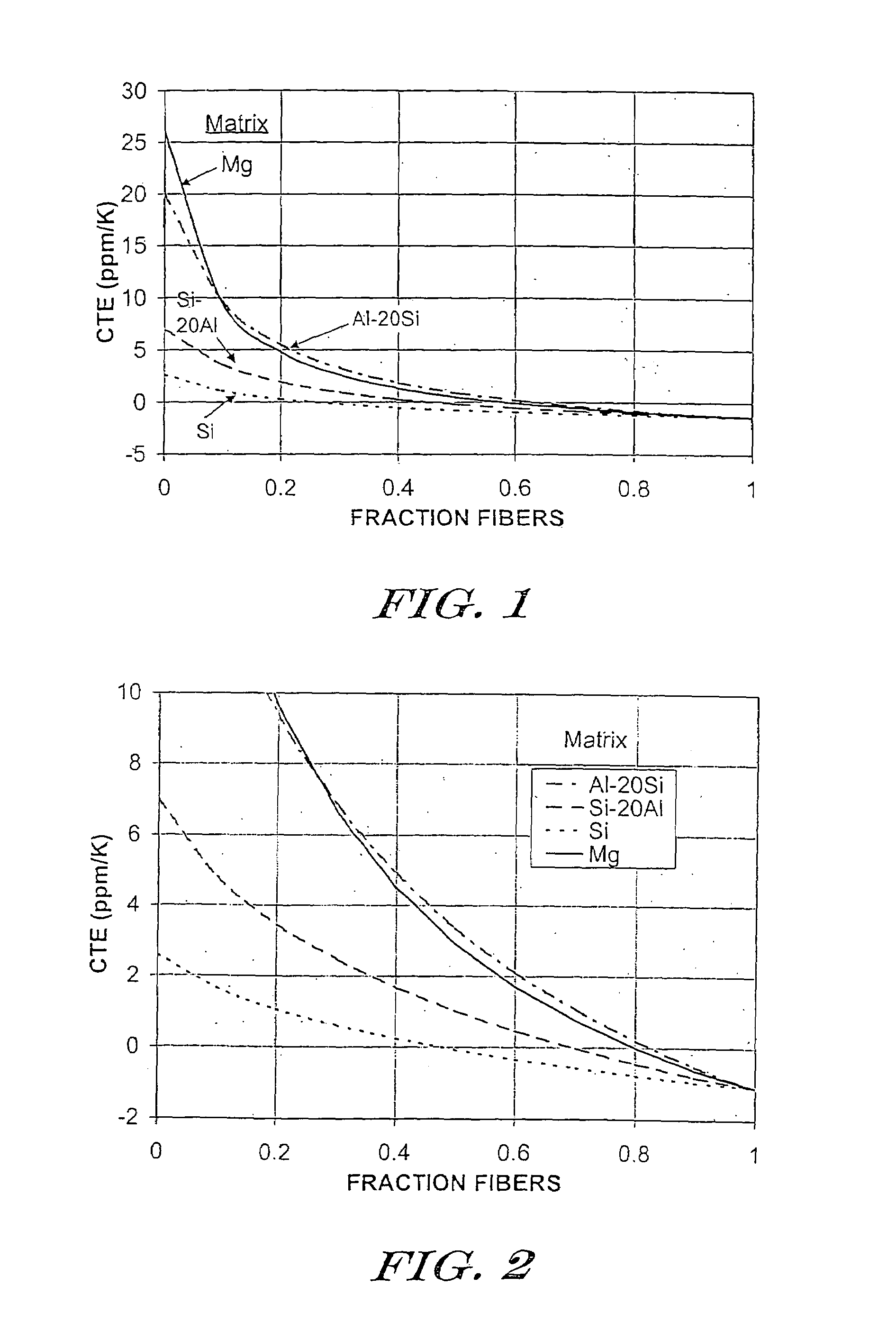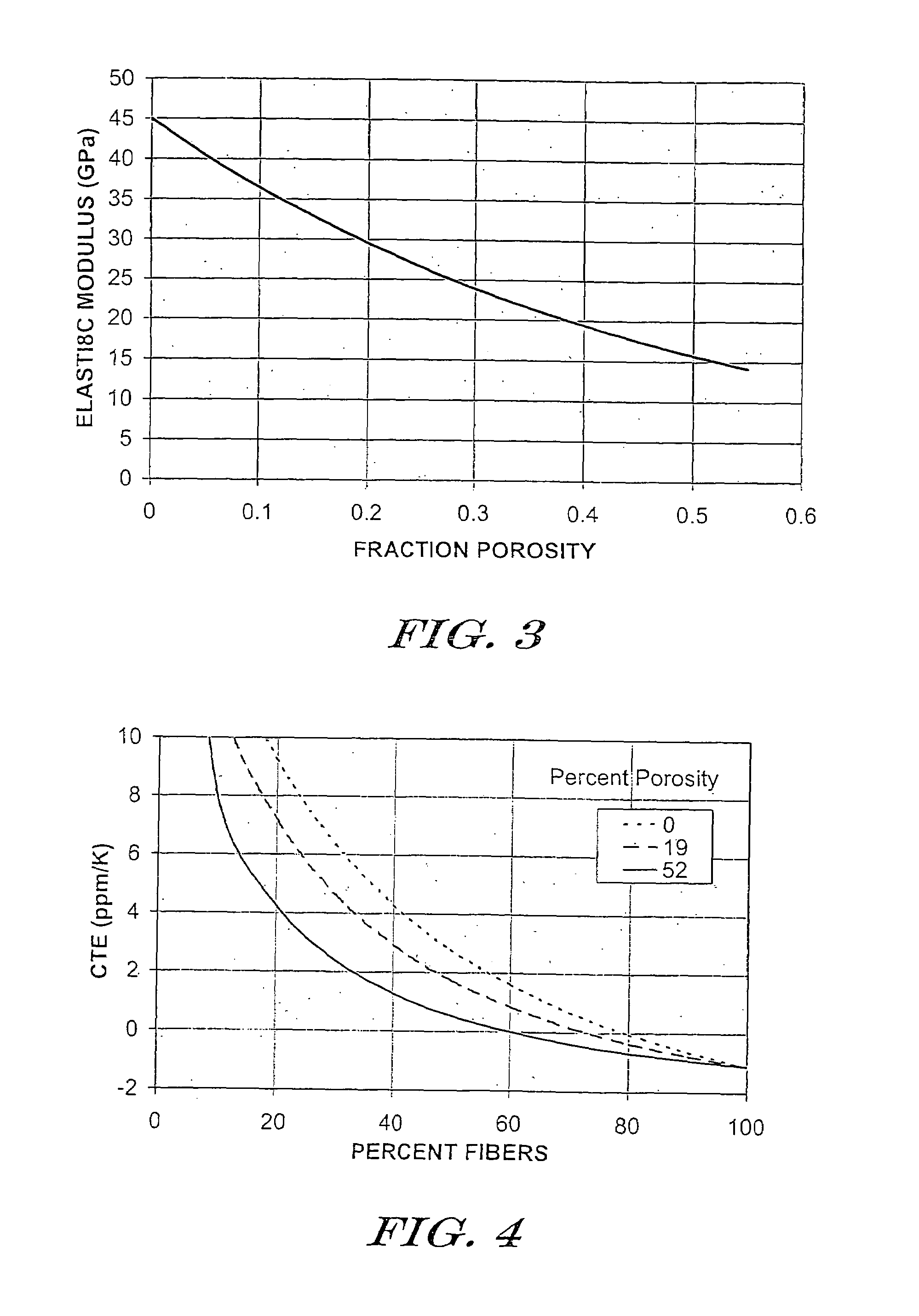Low expansion metal-ceramic composite bodies, and methods for making same
a technology low coefficient, which is applied in the field of metal-ceramic composite bodies, can solve the problems of inability to achieve sufficient fiber loading, and achieve the effect of low expansion, tougher and/or more impact resistan
- Summary
- Abstract
- Description
- Claims
- Application Information
AI Technical Summary
Benefits of technology
Problems solved by technology
Method used
Image
Examples
example i
[0083]This example demonstrates how a high modulus graphite fiber reinforced magnesium composite might be produced according to the present invention.
[0084]Plies of parallel graphite fibers are supplied as “prepregs.”
[0085]In accordance with the teachings of U.S. Pat. No. 3,888,661 to Levitt, the plies are then “dusted” with titanium metal particulate having an average particle size of about 44 microns. During subsequent processing, the titanium will help the magnesium to wet and bond to the graphite fibers. In addition, as the fiber plies are assembled, each ply is “salted” with a layer of magnesium filings.
[0086]The plies are then arranged quasi-isotropically in a refractory mold. In particular, if the orientation of the first ply is taken to be 0°, then the second ply is placed flat on top of the first ply such that it is oriented +45° with respect to the first ply. The third ply is then placed flat on top of the second ply and oriented −45° with respect to the first ply. The fou...
example ii
[0090]The procedures of Example 1 are repeated, except that the teachings of U.S. Pat. No. 4,056,874 to Kalnin should obviate the need for adding magnesium filings and titanium particulate wetting agent between the fiber plies. Instead, about 5 to 10 percent by weight of magnesium nitride is added to the magnesium melt, thereby permitting the molten magnesium to wet and infiltrate the carbon fibers on contact in a gaseous nitrogen atmosphere. Such a melt can be obtained by exposing a crucible of molten magnesium at a temperature of about 840 to 850° C. to an atmosphere of gaseous nitrogen for about 40 minutes. Magnesium nitride solid will form on the surface of the melt, and this reaction product then may be readily dispersed in the magnesium melt.
example iii
[0091]A quasi-isotropic lay-up is assembled as in Example 1, but without the magnesium filings or titanium particulate. After removing the temporary binder, a protective coating of silicon carbide is deposited onto the graphite fibers, for example, by chemical vapor deposition, thereby completing the lay-up. The lay-up is placed into a vacuum furnace. The furnace chamber is evacuated to less than about 100 millitorr, and heated to a temperature of about 1300° C. Upon contacting the coated fibers with a matrix metal comprising about Si-50Al, the molten metal is spontaneously wicked into the mass of coated fibers to form a composite body.
PUM
| Property | Measurement | Unit |
|---|---|---|
| elastic modulus | aaaaa | aaaaa |
| angle | aaaaa | aaaaa |
| angle | aaaaa | aaaaa |
Abstract
Description
Claims
Application Information
 Login to View More
Login to View More - R&D
- Intellectual Property
- Life Sciences
- Materials
- Tech Scout
- Unparalleled Data Quality
- Higher Quality Content
- 60% Fewer Hallucinations
Browse by: Latest US Patents, China's latest patents, Technical Efficacy Thesaurus, Application Domain, Technology Topic, Popular Technical Reports.
© 2025 PatSnap. All rights reserved.Legal|Privacy policy|Modern Slavery Act Transparency Statement|Sitemap|About US| Contact US: help@patsnap.com



